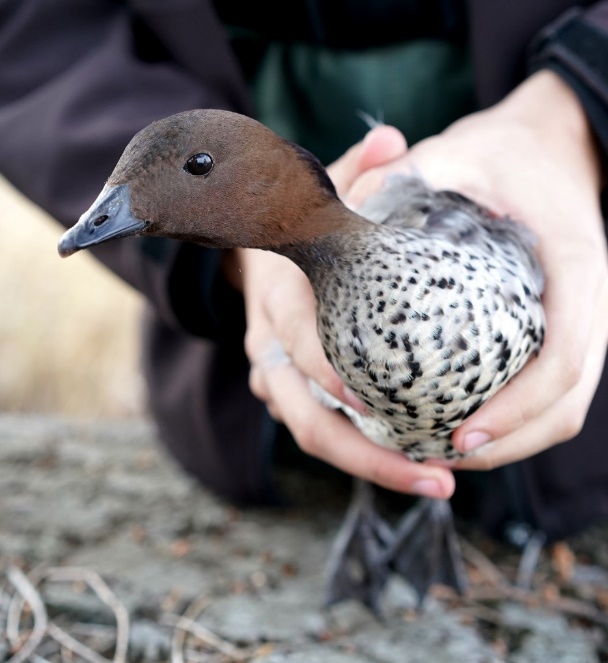Menu
The 2021 (Covid) Victorian duck shooting/rescue season
Despite very few duck shooters on the wetlands in 2021, this shocking cruelty was captured by a CADS’ photographer at Lake Lonsdale near Stawell, on the opening of the mid-week 2021 duck shooting season.
The Game Management Authority (GMA) investigated but failed to prosecute. As duck shooters are the GMA’s clients, is there a serious conflict of interest?
In the lead-up to the shortened 20-day season, duck shooters were encouraged to shoot on Little Lake Buloke, near the regional town of Donald. Little Lake Buloke is next to Lake Buloke where around 10,000 shooters would congregate for opening weekends in the late 1980s and early 1990s.
The CADS main duck rescue team, together with a large unit comprising Wildlife Victoria, Zoos Victoria staff, an x-ray machine and veterinarians, targeted Little Lake Buloke for the Wednesday opening and even though only around 35 duck shooters were present, violence and cruelty to native waterbirds still took place as captured in this footage of a shooter trying to put down a wounded bird.
The team moved to Lake Lonsdale near Stawell on Thursday, the second day of the season. Not a single shooter turned up. Other Victorian wetlands were also monitored for shooter numbers but there were very few shooters on any of the major wetlands on the opening weekend or during the rest of the season.
A Covid lockdown was announced by the government on the second day of the shooting season which meant that metropolitan shooters could not travel to the wetlands and regional shooters could not travel more than 5 km from home. Some rescuers, however, were able to travel further because of special permits to care for wildlife, and they joined regional Victorian rescuers who were able to cover wetlands in their areas.
Ballarat Courier, 2 June 2021
and also printed in the Bendigo Advertiser, 5 June 2021
In the lead-up to the final long weekend of the season, approximately 10,000 game birds had landed on Lake Cullen a Ramsar wetland of International Importance near Kerang. A team of rescuers swung into action to protect these birds as Lake Cullen had become the best shooting wetland in Victoria at that time and it was expected to be a very busy weekend. But, for those three days only three shooters surfaced and as far as rescuers could tell, not a single bird was shot.
Right: The sun sets on Lake Cullen at the end of the 2021 duck shooting season where around 10,000 native waterbirds were protected by our rescuers.
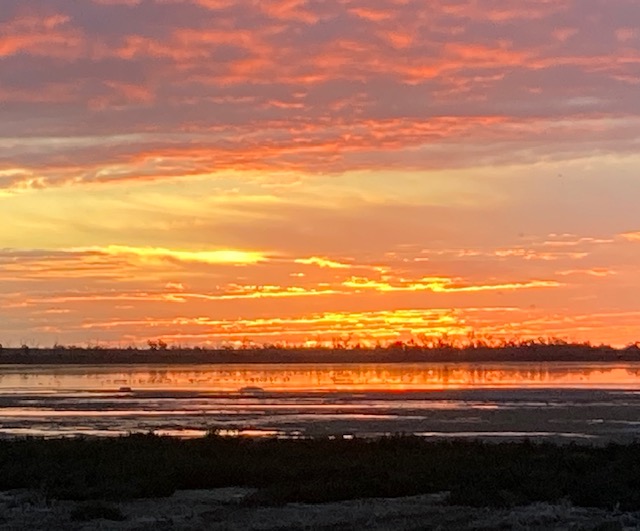
Above: The sun sets on Lake Cullen at the end of the 2021 duck shooting season where around 10,000 native waterbirds were protected by our rescuers.
Additional information
In the lead-up to the duck shooting season, surveys of as many Victorian wetlands as possible were carried out to determine the water conditions and numbers of so-called ‘game’, protected and threatened species. Alarmingly, our surveys confirmed what Professor Richard Kingsford stated in his ‘Aerial Survey of Wetland Birds in Eastern Australia’ (October 2020) that:
“Breeding species’ richness was extremely low, with only 3 species recorded breeding, the sixth lowest on record. Black swans comprised most of the breeding recorded (296), 81% of the total.
“All game species abundances were well below long term averages, in some cases by an order of magnitude; five out of eight species continue to show significant long term declines. Grey teal declined significantly from the previous year.”
On the wetlands we surveyed three to four months later, very few birds were seen. With NSW and Queensland experiencing heavy rains and flooding, waterbirds in Victoria would have flown north to the floodwaters.
Since 1983, Kingsford’s surveys show that waterbird numbers have declined by 90% but the Game Management Authority appears to be in the process of ignoring Kingsford’s aerial surveys and will instead rely on a dubious helicopter and drone survey of birds in Victoria, excluding NSW and Queensland. This is extremely dangerous. For example, when the other states are in drought and waterbirds have flown south seeking refuge in Victoria, it will be easy for shooters to decimate, not only the Victorian birds, but also those seeking refuge from NSW and/or Queensland. All native waterbirds are fully protected in NSW and Queensland but are likely to be obliterated when seeking sanctuary in Victoria. With the impact of climate change, if these birds are shot for recreational purposes it will put their species’ survival at risk.
Additional information
In the lead-up to the duck shooting season, surveys of as many Victorian wetlands as possible were carried out to determine the water conditions and numbers of so-called ‘game’, protected and threatened species. Alarmingly, our surveys confirmed what Professor Richard Kingsford stated in his ‘Aerial Survey of Wetland Birds in Eastern Australia’ (October 2020) that:
“Breeding species’ richness was extremely low, with only 3 species recorded breeding, the sixth lowest on record. Black swans comprised most of the breeding recorded (296), 81% of the total.
“All game species abundances were well below long term averages, in some cases by an order of magnitude; five out of eight species continue to show significant long term declines. Grey teal declined significantly from the previous year.”
On the wetlands we surveyed three to four months later, very few birds were seen. With NSW and Queensland experiencing heavy rains and flooding, waterbirds in Victoria would have flown north to the floodwaters.
Since 1983, Kingsford’s surveys show that waterbird numbers have declined by 90% but the Game Management Authority appears to be in the process of ignoring Kingsford’s aerial surveys and will instead rely on a dubious helicopter and drone survey of birds in Victoria, excluding NSW and Queensland. This is extremely dangerous. For example, when the other states are in drought and waterbirds have flown south seeking refuge in Victoria, it will be easy for shooters to decimate, not only the Victorian birds, but also those seeking refuge from NSW and/or Queensland. All native waterbirds are fully protected in NSW and Queensland but are likely to be obliterated when seeking sanctuary in Victoria. With the impact of climate change, if these birds are shot for recreational purposes it will put their species’ survival at risk.
Despite so few shooters active during 2021, they were still filmed showing:
- appalling cruelty;
- ignorance of how to kill wounded birds causing prolonged suffering;
- not checking if birds were dead before throwing into a boat, hanging on a belt or stuffing into a bag;
- failing to recover and kill wounded birds before targeting other birds;
- shooting above the bag limit;
- shooting outside the legal times at Sale;
- shooting out of range;
- ignorance of the regulations;
- illegally taking small children onto shooting wetlands;
- walking with unbroken guns;
- littering;
- illegally shooting from a moving boat: Wooroonook Lakes, June 5, 2021
- Some excellent post-season social media investigations detected on-line footage taken during the 2021 season showing several occasions when a shooter shot at two birds consecutively, illegally making no effort to collect the first bird before shooting at a second bird. The Game Management Authority is investigating.
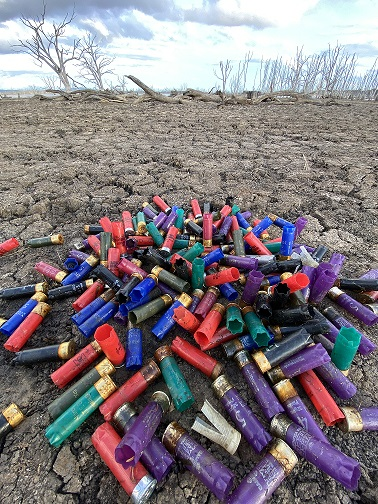
Above: Spent shotgun cartridges picked up by rescuers, Lake Toolondo, 6 June, 2021.
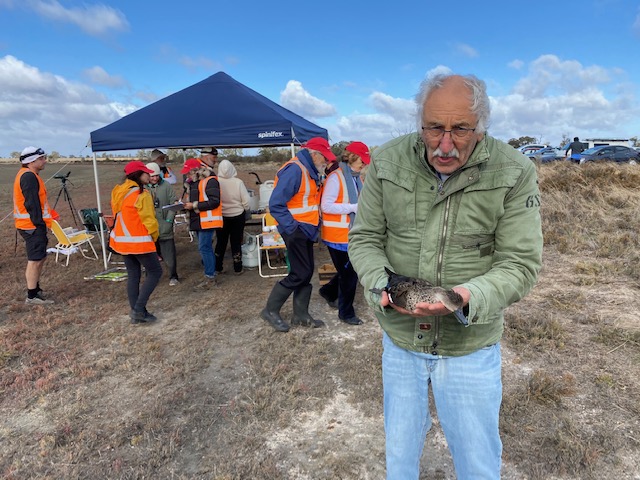
Laurie Levy holds a euthanased Grey Teal recovered on the 2021 opening morning.
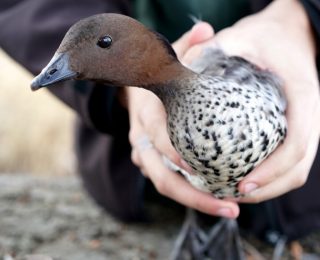
Injured Wood Duck from Lake Toolondo June 6, 2021.

